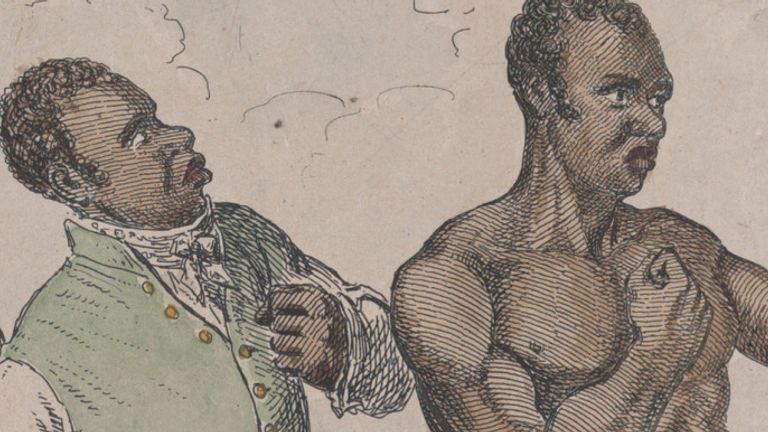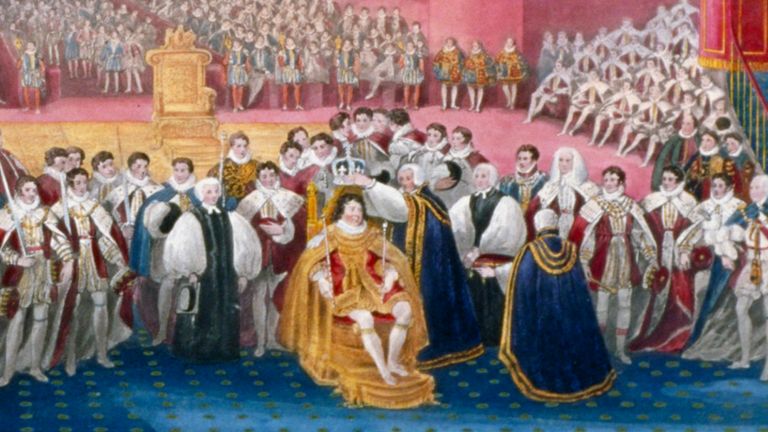
[ad_1]
Bill Richmond opens our Hidden Figures online series, running throughout Black History Month, bringing to life the stories of black sporting pioneers you may never have heard of
Last Updated: 02/10/20 9:22am

Bill Richmond watches on during the fight billed as ‘The Battle Between Cribb and Molineaux’ in 1811
Bill Richmond is one response you are unlikely to get if you ask someone to name a sporting great, but the bare-knuckle boxer, born in the 18th century, was arguably the first black sporting icon in history.
Born into slavery on Staten Island in New York in 1763, Richmond was released at the age of 13 to British army commander General Percy. Some reports say Percy was impressed by the fighting prowess of the young Richmond and took him to England where he was provided for and educated in York, later marrying a local woman.
Richmond was frequently targeted with racism and was involved in a number of street brawls locally. Writer Pierce Egan (1772-1849) noted five boxing matches won by Richmond, who was already developing a reputation as a dangerous counter-puncher on the underground scene in Yorkshire.
“Impetuous men must not fight Richmond as in his hands they become victims of their own temerity. The older he grows, the better pugilist he proves himself.”
Pierce Egan’s reaction to Richmond’s win over Tom Shelton
He moved to London near the turn of the 19th century where he was employed by naval officer and nobleman Lord Camelford – a man with a passion for pugilism, who was also cousin of then-Prime Minister William Pitt the Younger.
According to Luke G Williams, author of Richmond Unchained: the biography of the world’s first black sporting superstar, Richmond challenged George Maddox while in the company of Lord Camelford at a prize fight at Wimbledon Common, losing to the battle-hardened boxer inside nine brutal rounds.
It was Lord Camelford’s death in a duel with a former friend that was the catalyst for Richmond’s ring return. He earned memorable wins against Jack Holmes and Jewish fighter Youssop, and began training boxers, before losing to rising star Tom Cribb in a bruising 90-minute encounter in Sussex in 1805.

circa 1805: A portrait of boxer Bill Richmond (Photo by Rischgitz/Getty Images)
Undeterred, Richmond would mount another comeback in 1808 with a series of impressive wins, reigniting his popularity, and paving the way for a rematch with Maddox a year later.
An action-packed fight saw both men earn plaudits with Richmond’s status and reputation elevated further after avenging his earlier defeat to Maddox in fearsome style after a gruelling encounter.
‘Impetuous men must not fight Richmond’
After becoming landlord of the Horse and Dolphin pub in London’s Leicester Square, Richmond’s focus turned to training young contender Tom Molineaux, who later suffered two defeats to his former adversary Cribb.
But Richmond again returned to the ring in 1814 – aged 50 at the time – beating Jack Davis before locking horns with the durable Tom Shelton, a man who was described as half his age.

Richmond was an usher at the coronation of King George IV at Westminster Abbey in July 1821
He would beat Shelton in a 23-round battle of attrition, with Egan commenting at the time: “Impetuous men must not fight Richmond as in his hands they become victims of their own temerity. The older he grows, the better pugilist he proves himself.”
That appears to be Richmond’s last contest, ending with a record of 17 wins and two losses. He continued to train fighters – as well as socialites including peer and poet Lord Byron – after his retirement. And such was Richmond’s standing in society, he even acted as an usher at the coronation of King George IV in 1821.
It capped a remarkable rise from squared circles to royal circles for the trailblazing Richmond, who died eight years later in December 1829 at the age of 66. Richmond was inducted into the International Boxing Hall of Fame 170 years later in 1999.
[ad_2]
Source link